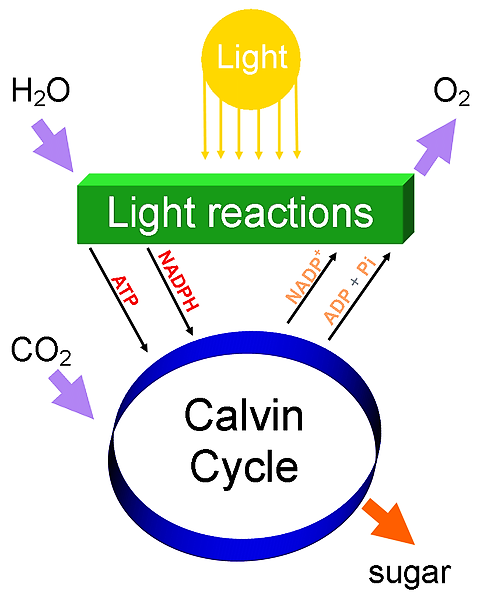
Which of the following is not essential for photosynthesis?
A. Oxygen
B. Carbon dioxide
C. Sunlight
D. Sunlight
Answer
564.6k+ views
Hint: Photosynthesis is a process of making food by green plants in the presence of sunlight. It is the process by which light energy gets converted into chemical energy. Plants require certain raw materials to carry out photosynthesis to produce food in the form of carbohydrates (i.e., glucose).
Complete step by step answer:
Option (A) is correct. Oxygen is not essential for the process of photosynthesis because oxygen is released in this process when plants utilize the raw materials i.e., carbon dioxide and water to produce sugars (glucose). Hence, it is not essential to carry out the process of photosynthesis.
Option (B) is incorrect. Carbon dioxide is an essential component of photosynthesis in plants to make food. It is the carbon dioxide molecule that reacts with water to form glucose and oxygen.
Option (C) is incorrect. Sunlight is one of the important requirements to carry out photosynthesis by plants. As photosynthesis is carried out in two phases i.e., light and dark phase so, in the light phase, energy from the sunlight is used to split the water molecule which releases two electrons that are used to form NADPH and ATP molecules.
Option (D) is incorrect. The whole process of photosynthesis takes place in the chloroplasts of a plant that contains a green-colored pigment called chlorophyll. It is the chlorophyll molecule that is meant for absorbing the light rays coming from the sun. Hence, it is essential for photosynthesis.

Hence, the correct option is (A)
Note:
Plants containing chlorophyll use carbon dioxide, water, and sunlight to produce food (in the form of glucose) and release oxygen with the formation of ATP and NADPH. As oxygen is produced by plants, so, it is not an essential component to start the process of photosynthesis.
Complete step by step answer:
Option (A) is correct. Oxygen is not essential for the process of photosynthesis because oxygen is released in this process when plants utilize the raw materials i.e., carbon dioxide and water to produce sugars (glucose). Hence, it is not essential to carry out the process of photosynthesis.
Option (B) is incorrect. Carbon dioxide is an essential component of photosynthesis in plants to make food. It is the carbon dioxide molecule that reacts with water to form glucose and oxygen.
Option (C) is incorrect. Sunlight is one of the important requirements to carry out photosynthesis by plants. As photosynthesis is carried out in two phases i.e., light and dark phase so, in the light phase, energy from the sunlight is used to split the water molecule which releases two electrons that are used to form NADPH and ATP molecules.
Option (D) is incorrect. The whole process of photosynthesis takes place in the chloroplasts of a plant that contains a green-colored pigment called chlorophyll. It is the chlorophyll molecule that is meant for absorbing the light rays coming from the sun. Hence, it is essential for photosynthesis.

Hence, the correct option is (A)
Note:
Plants containing chlorophyll use carbon dioxide, water, and sunlight to produce food (in the form of glucose) and release oxygen with the formation of ATP and NADPH. As oxygen is produced by plants, so, it is not an essential component to start the process of photosynthesis.
Recently Updated Pages
Why are manures considered better than fertilizers class 11 biology CBSE

Find the coordinates of the midpoint of the line segment class 11 maths CBSE

Distinguish between static friction limiting friction class 11 physics CBSE

The Chairman of the constituent Assembly was A Jawaharlal class 11 social science CBSE

The first National Commission on Labour NCL submitted class 11 social science CBSE

Number of all subshell of n + l 7 is A 4 B 5 C 6 D class 11 chemistry CBSE

Trending doubts
Differentiate between an exothermic and an endothermic class 11 chemistry CBSE

10 examples of friction in our daily life

One Metric ton is equal to kg A 10000 B 1000 C 100 class 11 physics CBSE

Difference Between Prokaryotic Cells and Eukaryotic Cells

1 Quintal is equal to a 110 kg b 10 kg c 100kg d 1000 class 11 physics CBSE

State the laws of reflection of light




